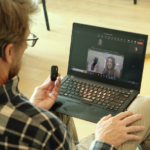Written by Guest Author, Dr. Abby Meyer, MD, MPH, FAAP
Congenital cytomegalovirus (cCMV) infection is the most common congenital infection with an estimated prevalence of approximately 1 in 200 births. It is the leading nongenetic cause of sensorineural hearing loss (SNHL) in childhood. Most cCMV infections are not clinically apparent, but all children with cCMV, whether they are “symptomatic” or “asymptomatic” are at risk for hearing loss. Hearing loss secondary to cCMV can be present at birth or develop years later, can affect 1 or both ears, and is often progressive in nature.
There is no consensus as to the best way to screen newborns for cCMV1. Some advocate for hearing-targeted screening for cCMV where only those newborns who do not pass newborn hearing screening are tested for cCMV. The significant disadvantage of hearing-targeted screening for cCMV is it will miss the 28%2 to43%3 of cCMV-related SNHL that is not present at birth, putting these children at risk for delayed identification of hearing loss and associated risk for negative impact on speech and language outcomes. Others advocate for universal screening for cCMV where all newborns are tested for cCMV, which allows for identification of all cases of cCMV. Currently, two provinces in Canada (Ontario and Saskatchewan) and two states in the US (Minnesota and New York) screen all newborns for cCMV. In addition, Connecticut is working to implement universal cCMV screening in 2025.
Expansion to universal screening for cCMV has brought up many valid questions:
- Why would you screen for a condition that most often is asymptomatic?
- Does having a positive screen for cCMV in an asymptomatic newborn result in undue stress and anxiety for the family and “overmedicalization” of the child?
- Will there be overtreatment with antiviral therapy?
The answer: It is all about the hearing!
An undeniable advantage of identifying all newborns with cCMV and thus at risk of cCMV-related SNHL is the opportunity to perform serial audiologic monitoring. The advantages of early identification of SNHL are well accepted4. Data out of Ontario2 suggest that progression of cCMV-related SNHL is common, often occurs early in life and can be rapid. Therefore, monitoring of the hearing of infants with cCMV must be early and frequent. In my home state of Minnesota, the first state to institute universal screening for cCMV via the Vivian Act (The Vivian Act – MN Dept. of Health), the Minnesota Department of Health has published audiology guidelines ( Section 4: Audiology Guidelines For Infants With Congenital Cytomegalovirus) which include the suggested audiological assessment and monitoring of children with cCMV. This also includes screening for vestibular dysfunction given the known increased prevalence of vestibular dysfunction identified in children with cCMV5.
Following these guidelines has allowed my colleagues and I at Children’s Minnesota to better monitor the hearing of our patients with cCMV. For example, we have identified significant SNHL on the 2nd diagnostic audiologic assessment at 4 months of age in infants who had a normal ABR in both ears at the initial diagnostic audiologic assessment at 1 month of age. Without knowing these infants had cCMV, their hearing would not have been monitored as closely, the delayed onset SNHL would not have been identified in a timely fashion, and the opportunity to optimize intervention for these infants would have been lost. In at least one infant, this included cochlear implantation which we were still able to pursue at an early age without unnecessary delay.
It is also important to note that with the updated recommendations from the American Academy of Pediatrics Committee on Infectious Diseases in 2024, intervention for infants with proven cCMV-related SNHL but no other signs or symptoms of cCMV now includes 6 weeks of valganciclovir, an antiviral medication that has been used to treat symptomatic cCMV. This change in recommendation was based on results from the CONCERT study6 that showed a treatment benefit for infants with confirmed cCMV infection and SNHL and no other features of cCMV disease.
As hearing healthcare professionals, it is imperative that we are knowledgeable about cCMV so we can provide the best care for children with cCMV and be a resource for others on this condition. According to the National CMV Foundation (National CMV Foundation – Cytomegalovirus (CMV) | National CMV Foundation), 91% of women do not know about cCMV. I encourage all of you reading this article to do your part to lower this statistic:
- Talk to your patients/families and colleagues about cCMV
- Get involved at your local or state level to advocate for cCMV education and screening policies.

For additional information, please listen to my episode of Beyond the Decibels. You can access this episode on all major streaming apps or by using this link: Abby Meyer, MD: Why screen for CMV?
We can make a difference!

About the author: Dr. Meyer is a Pediatric Otolaryngologist who attended medical school at the University of Minnesota and completed otolaryngology residency at the University of Minnesota. She went on to complete a fellowship in pediatric otolaryngology at the University of Washington and Seattle Children’s Hospital and an MPH in Epidemiology at the University of Minnesota School of Public Health. Her interests include all aspects of pediatric otolaryngology but especially caring for children who have been identified as deaf or hard of hearing (DHH), as well as chronic ear disease, cleft palate and velopharyngeal insufficiency, and neck masses including thyroid masses. She is also the Pediatric Otolaryngologist on the Midwest Fetal Care Center team. Outside of work she enjoys supporting the local sports teams, Peloton, anything Star Wars, reading fiction, and spending time with her husband and 2 sons.
- Schleiss MR. Newborn Screening for Congenital Cytomegalovirus (cCMV) Infection: Universal, Targeted, Expanded-Targeted, or None-of-the-Above? Neonatol Today. 2024 Aug;19(8):3-12. PMID: 39445079; PMCID: PMC11498343.
- Cushing SL, Purcell PL, Papaiaonnou V, Neghandi J, Daien M, Blaser SI, Ertl-Wagner B, Wagner M, Sheng M, James AL, Bitnun A, Papsin BC, Gordon KA. Hearing Instability in Children with Congenital Cytomegalovirus: Evidence and Neural Consequences. Laryngoscope. 2022 Sep;132 Suppl 11:S1-S24. doi: 10.1002/lary.30108. Epub 2022 Mar 18. PMID: 35302239.
- Fowler KB, McCollister FP, Sabo DL, Shoup AG, Owen KE, Woodruff JL, Cox E, Mohamed LS, Choo DI, Boppana SB; CHIMES Study. A Targeted Approach for Congenital Cytomegalovirus Screening Within Newborn Hearing Screening. Pediatrics. 2017 Feb;139(2):e20162128. doi: 10.1542/peds.2016-2128. Epub 2017 Jan 3. PMID: 28049114; PMCID: PMC5260148.
- Yoshinaga-Itano C. From Screening to Early Identification and Intervention: Discovering Predictors to Successful Outcomes for Children With Significant Hearing Loss. J Deaf Stud Deaf Educ. 2003 Winter;8(1):11-30. doi: 10.1093/deafed/8.1.11. PMID: 15448044.
- Shears A, Yan G, Mortimer H, Cross E, Sapuan S, Kadambari S, Luck S, Heath PT, Walter S, Fidler KJ. Vestibular and balance dysfunction in children with congenital CMV: a systematic review. Arch Dis Child Fetal Neonatal Ed. 2022 May 11;107(6):630–6. doi: 10.1136/archdischild-2021-323380. Epub ahead of print. PMID: 35545420; PMCID: PMC9606507.
- Chung PK, Schornagel FAJ, Soede W, van Zwet EW, Kroes ACM, Oudesluys-Murphy AM, Vossen ACTM. Valganciclovir in Infants with Hearing Loss and Clinically Inapparent Congenital Cytomegalovirus Infection: A Nonrandomized Controlled Trial. J Pediatr. 2024 May;268:113945. doi: 10.1016/j.jpeds.2024.113945. Epub 2024 Feb 8. PMID: 38336204.
Views expressed are those of the individual. Consult your hearing health provider to determine if you are a candidate for Cochlear technology. Outcomes and results may vary.


